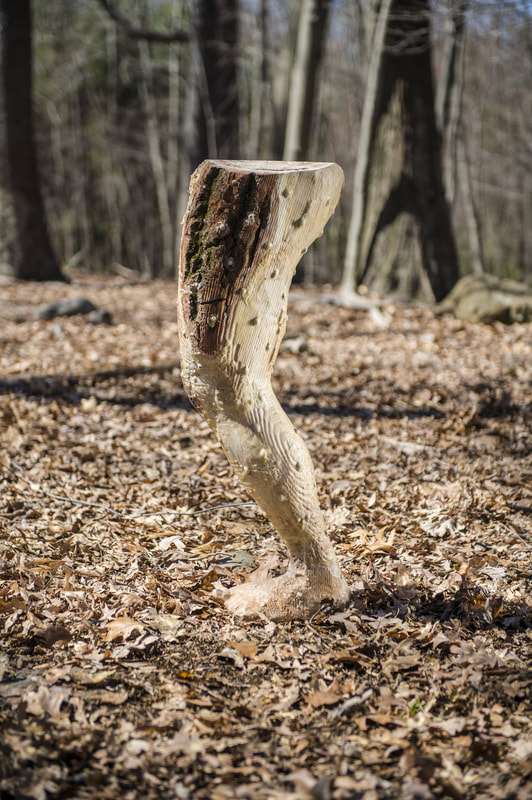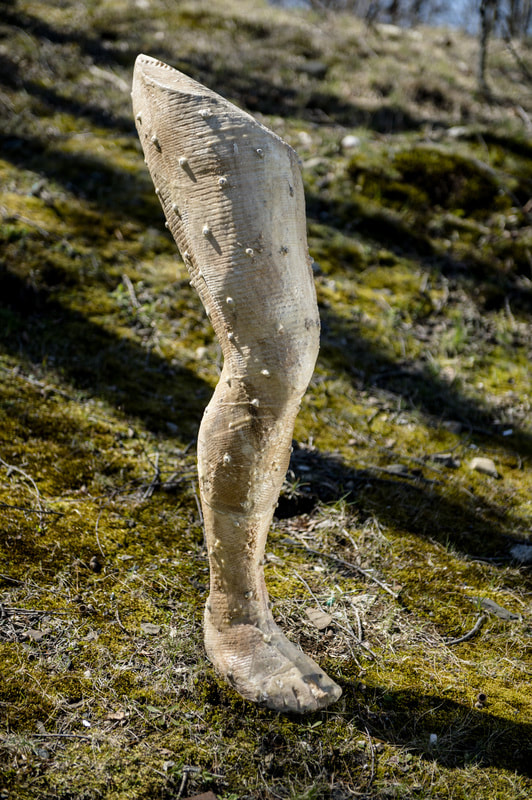The Foundation of Animalia and Fungi
Part of the permanent collection at Price Sculpture Forest.
The Foundation of Fungi and Animalia is a sculpture which addresses how intertwined life on our planet is. It specifically looks at connections between humans, fungi, and trees. The sculptural form consists of two human legs in a walking position milled from oak logs. The legs are coated in beeswax, the legs have bumps all over them. The bumps represent the fungi and how the spores spread. The legs and feet are humanity’s foundation and connection to the earth. The oak logs represent our reliance on wood. The more we look at our ecology we see that we depend upon every part of the environment. To disregard any one part of the environment is to harm a part of ourselves. While I became specifically interested in Mycology and its relationship to humanity, this work is meant to connect humans to the earth. We grow with the earth, and die with the earth. We return to the earth because we are all the earth. The beeswax brings a flesh like look to the legs while also connecting bees to this interconnectedness of species. These sculptures will become a part of the ecology, becoming home to fungus, insects, and other vegetation. Thus the human form giving life to nature instead of constantly taking.
The sculpture is made using 3D technologies. The legs are 3D scans of a model posing in a similar position to the Auguste Rodin sculpture Portrait of Balzac. The 3D model created from these scans is then manipulated to achieve proper size and appearance. This Model is then milled using a 7 axis robotic CNC machine. This process creates digital data of the sculpture that exists separate from the physical work, while also embedding the algorithmically produced milling pattern on the sculpture. This digital debris codes the sculpture to a specific place in time. Making it of the time while using the natural materials and materials to address timeless issues. The virtual world is a growing and changing place that as AI advances will one day be deemed a life form. This sculpture will indirectly be connected to another life system as these digital modes develop. This will allow for the work to be recreated and updated as its natural life decays. The life cycle of materials can continue, but the life of the sculptural form can be remade as needed. As Hito Steyerl states in ‘In Defense of the Poor Image’: “The poor image is no longer about the real thing—the originary original. Instead, it is about its own real conditions of existence: about swarm circulation, digital dispersion, fractured and flexible temporalities. It is about defiance and appropriation just as it is about conformism and exploitation.”
This sculpture is influenced by the scientific work of Thomas Cavalier-Smith, Herbert Copeland, and Paul Stamets. Cavalier-Smith and Copeland were a big part of developing taxonomy or the naming and classification of all living organisms. Cavalier-Smith has pioneered research into fungi and finds that it shares more than 50 percent of DNA with humans, thus leading to the development of a new Supergroup classification called Opisthokonta mapping Fungi closer to the animal kingdom than with the kingdom with which they are traditionally associated. A common characteristic of opisthokonts is that flagellate cells, such as the sperm of most animals and the spores of the chytrid fungi, propel themselves with a single posterior flagellum. Paul Stamets is a mycologist who advocates for the medicinal use of mushrooms, but also for their ecological importance. Some of his research includes evidence of mycelium being large communication networks in old growth forests. The vast networks of mycelium being tapped by vegetation as well as fungi beneath the forest floor.
The sculpture is made using 3D technologies. The legs are 3D scans of a model posing in a similar position to the Auguste Rodin sculpture Portrait of Balzac. The 3D model created from these scans is then manipulated to achieve proper size and appearance. This Model is then milled using a 7 axis robotic CNC machine. This process creates digital data of the sculpture that exists separate from the physical work, while also embedding the algorithmically produced milling pattern on the sculpture. This digital debris codes the sculpture to a specific place in time. Making it of the time while using the natural materials and materials to address timeless issues. The virtual world is a growing and changing place that as AI advances will one day be deemed a life form. This sculpture will indirectly be connected to another life system as these digital modes develop. This will allow for the work to be recreated and updated as its natural life decays. The life cycle of materials can continue, but the life of the sculptural form can be remade as needed. As Hito Steyerl states in ‘In Defense of the Poor Image’: “The poor image is no longer about the real thing—the originary original. Instead, it is about its own real conditions of existence: about swarm circulation, digital dispersion, fractured and flexible temporalities. It is about defiance and appropriation just as it is about conformism and exploitation.”
This sculpture is influenced by the scientific work of Thomas Cavalier-Smith, Herbert Copeland, and Paul Stamets. Cavalier-Smith and Copeland were a big part of developing taxonomy or the naming and classification of all living organisms. Cavalier-Smith has pioneered research into fungi and finds that it shares more than 50 percent of DNA with humans, thus leading to the development of a new Supergroup classification called Opisthokonta mapping Fungi closer to the animal kingdom than with the kingdom with which they are traditionally associated. A common characteristic of opisthokonts is that flagellate cells, such as the sperm of most animals and the spores of the chytrid fungi, propel themselves with a single posterior flagellum. Paul Stamets is a mycologist who advocates for the medicinal use of mushrooms, but also for their ecological importance. Some of his research includes evidence of mycelium being large communication networks in old growth forests. The vast networks of mycelium being tapped by vegetation as well as fungi beneath the forest floor.
©2016-2023 David D'Ostilio - All rights reserved

